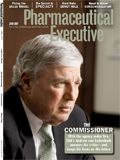Marketing to Professionals: The Advertorial Effect
Pharmaceutical Executive
Advertorials were shown to be more effective than branded ads in terms of generating interest, providing valuable info, and provoking follow-up discussions
Both branded advertisements and advertorials—"news articles" that are paid for or sponsored by marketers—can help introduce physicians to a new product. But while branded spots are still the primary communication vehicle with this audience, a new study suggests advertorials do a better job at delivering an educational message.

Johanna Schlossberg
Unlike traditional journal ads, advertorials are not designed to hard-sell brands. They're usually written in a news magazine format, but also employ elaborate illustrations and detailed stories that aren't always used in traditional stories. Advertorials are typically scientific and educational in nature and are used to achieve one of the following objectives: communicate an unmet need within a category, increase disease state awareness, influence or change a treatment paradigm, or explain a new mechanism of action (MOA).
Many marketers purchase advertorial space prior to the launch of a drug in order to boost interest in the drug's MOA, and to educate physicians on how to use the product. However, there is less evidence to support using advertorials once a product was already approved. The Association of Healthcare Media Directors (AHMD), working with research firm The Matalia Group, initiated a study to understand the relative effectiveness of advertorials run concurrently with branded advertising, and to determine which types of advertorials resonate most with readers.
As part of the study, the AHMD mailed one of six pieces of creative (three branded ads and three advertorials) and a questionnaire to a group of 300 primary care physicians randomly selected from the AMA database. The results discussed are based on 411 responses (about 23 percent)—an above-average response rate for this audience.

Gwen Canter
Gauging Success
The results show that, in message credibility, advertorials were equally as effective as branded ads. However, advertorials were shown to be more effective than branded ads in terms of generating interest, providing valuable information, and provoking follow-up discussions with drug reps or colleagues. The findings indicate that advertorials accomplish their overall goal, which is to educate physicians. In fact, a large majority of physicians believed that advertorials helped them better understand a disease or health condition (see "Advertorial Versus Branded,").
Interest Overall, readers found advertorials more interesting than branded ads, likely due to the educational nature of their content. More than three out of four respondents (76.3 percent) were "somewhat" or "very interested" in the advertorials. Nevertheless, branded ads ranked only slightly lower in interest than advertorials: almost two thirds of readers (59.6 percent) were "somewhat" or "very interested" in the branded ads. The study suggests that physicians respond favorably to journal advertising and find both advertorials and branded ads to be of interest.
Provoke readers to action More physicians were likely to take action after reviewing an advertorial than reviewing a branded ad. More than 29 percent of respondents claimed that viewing the advertorial would prompt them to discuss this subject with a drug rep compared to 20.2 percent viewing a branded ad. Advertorials also motivated readers to search for literature online and to discuss this with their colleagues. This is not surprising, given that advertorials are typically intended to challenge current thinking.

Advertorial Versus Branded
Deliver educational value Physicians clearly understood that advertorials provide educational, rather than promotional, value. Seven out of ten physicians viewed advertorials as educational while four out of ten regarded branded ads as educational. Over half (57.5 percent) considered branded ads as mostly or somewhat promotional, and advertorials proved to be more effective than branded ads in improving readers' understanding of the target disease state or health condition (61 percent versus 55.8 percent).
Believability The believability of advertorials is a key concern to product managers and agencies, as it motivates readers to take action. Advertorials and branded ads were both considered believable, with a slight advantage for advertorials. Eighty-one percent of respondents considered advertorials to be believable, while 78 percent also considered branded ads believable.
Who Are the Doctors?
As one would expect, the study showed a differential impact of advertorials depending on the readers' practice setting, age, and patient volume.
Physicians in private practice found advertorials both more interesting and easier to read than hospital-based physicians. In addition, respondents in group settings were more likely to ask questions of company reps after seeing an advertorial as opposed to seeing a branded ad.
The study showed that more experienced physicians (20+ years in practice) were more interested in advertorials than branded ads, and were more likely to discuss an advertorial message with a sales rep than a branded ad message. However, branded ads appeared to influence their diagnosis and treatment decision more than advertorials.
Younger physicians found branded ads easier to read but indicated advertorials were more interesting. In fact, they seemed more likely to seek further information from drug reps, colleagues or the Internet after seeing advertorials.
Respondents with low patient volume (less than 61 per week) found advertorials more believable, easier to read, and more helpful in understanding the disease state or condition than branded ads. However, it was the busier respondents (100+ patients per week) who were more likely to seek further information after seeing an advertorial than their low-volume colleagues.
Read Between the Graphics
What advertorials look like is just as important as how they read, and how dense or light the graphics are is very important when choosing an advertorial style. Layout and text-to-graphics ratio can impact believability. The advertorials used in this study varied significantly in their use of text and graphics, and incorporated one of the following combinations:
- low graphics/high text (LGHT)
- moderate graphics/moderate text (MGMT)
- high graphics/low text (HGLT).
LGHT—this advertorial was considered more believable than either MGMT or HGLT. Nine out of ten respondents considered the LGHT advertorial to be "very" or "somewhat" believable.
HGLT and MGMT—these advertorials were deemed easier to read. Many respondents considered the LGHT advertorial "not at all" easy to read.
Keep in mind that the ratio of text to graphics influences credibility as well as ease of reading. An advertorial can have more text than a branded ad without sacrificing readability, but in order to maintain both believability and ease of reading, an advertorial must have the right balance of text and graphics.
The decision to create one type of ad over another hinges on the communication objective. If the objective is to educate the audience on a disease state or condition or to challenge current treatment behavior, advertorials offer an advantage over branded ads. If the objective is brand awareness and differentiation, branded ads are more effective.
So how effective are advertorials? Based on the study findings, advertorials should be considered an effective part of the media mix, particularly as a means of supplementing branded messages with educational topics. In order to maximize the effectiveness of this media, it is recommended that advertorials be included as part of a fully integrated campaign. According to respondents, advertorials can be just as believable and useful as branded ads, and have a greater power to motivate readers to seek further information.
Additional research provided by the Association of Healthcare Media Directors members Linda Ciccarelli, Debbie Renner, Johanna Tompetrini, and The Matalia Group president Ned Matalia.
Johanna Schlossberg is associate media director at Cline, Davis & Mann. She can be reached at jschlossberg@clinedavis.com
Gwen Canter is vice president, media director at Sudler & Hennessey. She can be reached at gwen.canter@sudler.com

The Misinformation Maze: Navigating Public Health in the Digital Age
March 11th 2025Jennifer Butler, chief commercial officer of Pleio, discusses misinformation's threat to public health, where patients are turning for trustworthy health information, the industry's pivot to peer-to-patient strategies to educate patients, and more.
Navigating Distrust: Pharma in the Age of Social Media
February 18th 2025Ian Baer, Founder and CEO of Sooth, discusses how the growing distrust in social media will impact industry marketing strategies and the relationships between pharmaceutical companies and the patients they aim to serve. He also explains dark social, how to combat misinformation, closing the trust gap, and more.